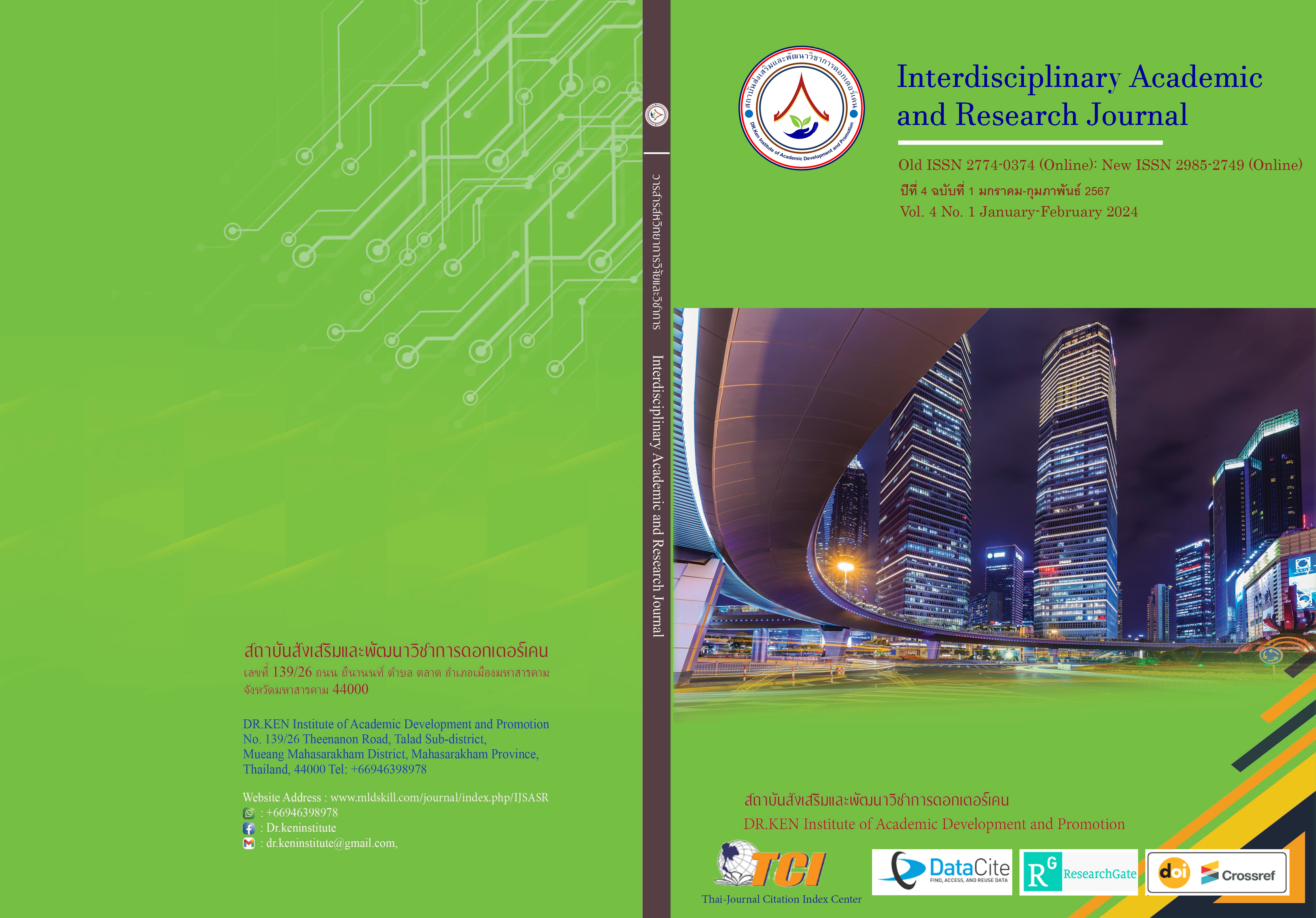Health Promotion Concept Implementing Health Education in Small Schools in Thailand within the Context of Sustainable Development
DOI:
https://doi.org/10.60027/iarj.2024.273375Keywords:
Health Promotion; , Health Education; , Sustainable DevelopmentAbstract
Background and Aims: Health promotion is essential because the world is changing rapidly, affecting humans in various ways. Human health is influenced by multiple factors, including personal, environmental, and workplace elements. Schools are crucial environments that play a significant role in promoting the health of students and the community. Specifically, health education activities are provided to students, marking the initiation of good health practices. Therefore, the objective of this study was to study the concept of health promotion using health education in small schools in Thailand within the context of sustainable development.
Methodology: This study analyzed relevant academic documents. Then the content will be analyzed and presented descriptively.
Results: Therefore, health education activities should be tailored to enable students to sustainably modify their behavior and keep pace with the changes in today's world by fostering knowledge, values, attitudes, and responsibilities for their own health and the well-being of the community. Furthermore, school collaboration with community agencies stands out as one of the keys to fostering good health among students and individuals in the community.
Conclusion: Adjusting physical education activities is essential to facilitate sustainable behavior change in students, aligning with the current global transformations. This involves promoting knowledge, values, attitudes, and responsibility towards personal and community health. Additionally, school collaboration with community organizations is a key factor in fostering long-term health benefits for both students and the community.
References
กรมอนามัย. (2558). คู่มือการดําเนินงานโรงเรียนส่งเสริมสุขภาพ. สำนักส่งเสริมสุขภาพ กรมอนามัย.
กระทรวงศึกษาธิการ. (2560). หลักสูตรแกนกลางการศึกษาขั้นพื้นฐาน พ.ศ. 2551 (ปรับปรุง พ.ศ. 2560). กระทรวงศึกษาธิการ. Retrieved from: https://academic.obec.go.th/images/document/1559878925_d_1.pdf
กระทรวงศึกษาธิการ. (2566). นโยบายและจุดเน้นของกระทรวงศึกษาธิการ ประจำปีงบประมาณ พ.ศ. 2567. กระทรวงศึกษาธิการ. Retrieved from: https://www.moe.go.th/360policy-and-focus-moe-fiscal-year-2024/
กระทรวงสาธารณสุข. (2559). แผนยุทธศาสตร์ชาติระยะ 20 ปี (ด้านสาธารณสุข). กรุงเทพฯ: สำนักปลัดกระทรวงสาธารณสุข.
ทศพร กานติมาอัศจรรย์. (2561). สภาพและปัญหาการสอนพลศึกษาตามความคิดเห็นของครูผู้สอนพลศึกษา ในโรงเรียนประถมศึกษาจังหวัดกาญจนบุรี. สถาบันการพลศึกษา วิทยาเขตสุพรรณบุรี.
มิ่งขวัญ ศิริโชติ. (2562). การบริหารกิจกรรมส่งเสริมสุขภาพในโรงเรียน. วารสารวิชาการ สถาบันวิทยาการจัดการแห่งแปซิฟิค, 5(2), 289–296.
โรงเรียนบ้านถ้ำน้ำบัง. (2557). โรงเรียนขนาดเล็กที่มีวิธีปฏิบัติเป็นเลิศ ประจำปี 2557. สำนักงานเขตพื้นที่การศึกษาประถมศึกษาเพชรบูรณ์ เขต 1.
สมบัติ ธำรงธัญวงศ์. (2557). ปัญหาโรงเรียนขนาดเล็กที่ต้องเร่งแก้ไข. Retrieved from: https://www.facebook.com/Prof.SombatThamrongthanyawong/posts/787389251302068
สำนักงานคณะกรรมการการศึกษาขั้นพื้นฐาน. (2564). หลักสูตรฐานสมรรถนะกลุ่มสาระการเรียนรู้สุขศึกษาและพลศึกษา. Retrieved from: https://cbethailand.com
สำนักงานคณะกรรมการข้าราชการครูและบุคลากรทางการศึกษา. (2563a). เกณฑ์อัตรากำลังครูและบุคลากรทางการศึกษาในสถานศึกษา สังกัดสำนักงานคณะกรรมการการศึกษาขั้นพื้นฐาน. สำนักปลัดกระทรวงศึกษาธิการ. Retrieved from: https://otepc.go.th/images/00_YEAR2563/06_PB/circular_document/v23-63.pdf
สำนักงานคณะกรรมการข้าราชการครูและบุคลากรทางการศึกษา. (2563b). หลักเกณฑ์และวิธีการสอบแข่งขัน เพื่อบรรจุและแต่งตั้งบุคคลเข้ารับราชการเป็นข้าราชการครูและบุคลากรทางการศึกษา ตำแหน่ง ครูผู้ช่วย. สำนักงานคณะกรรมการข้าราชการครูและบุคลากรทางการศึกษา. Retrieved from: https://circular62.otepc.go.th
สำนักงานสภาพัฒนาการเศรษฐกิจและสังคมแห่งชาติ. (2561). ยุทธศาสตร์ชาติ 20 ปี. สำนักงานสภาพัฒนาการเศรษฐกิจและสังคมแห่งชาติ. Retrieved from: http://nscr.nesdc.go.th/ns/
สำนักงานสภาพัฒนาการเศรษฐกิจและสังคมแห่งชาติ. (2566). แผนพัฒนาเศรษฐกิจและสังคมแห่งชาติ ฉบับที่ 13 (พ.ศ. 2566-2570). สำนักงานสภาพัฒนาการเศรษฐกิจและสังคมแห่งชาติ. Retrieved from: https://www.nesdc.go.th/download/Plan13/Doc/Plan13_Final.pdf
Baumann, L.C., & Karel, A. (2013). Health Education. In M.D. Gellman & J.R. Turner (Eds.), Encyclopedia of Behavioral Medicine (pp. 917–918). Springer. https://doi.org/10.1007/978-1-4419-1005-9_320
Edwards, V.L. (2013). A theory of participation for 21st century governance. International Journal of Organization Theory and Behavior, 16(1), 1–28.
Egger, G. (1999). Health Promotion Strategies and Methods. In Health Promotion Strategies & Methods. McGraw-Hill Book Company.
Farin, E., Ullrich, A., & Nagl, M. (2013). Health education literacy in patients with chronic musculoskeletal diseases: Development of a new questionnaire and sociodemographic predictors. Health Education Research, 28(6), 1080–1091. https://doi.org/10.1093/her/cyt095
Jegede, O.J., & Taylor, P.C. (1995). The Role of Negotiation in Constructivist-Oriented Hand-On and Minds-On Science Laboratory Classroom. Annual Meeting of the American Educational Research Association (AERA) 1995. San Francisco, CA.
Mckinlay, J.B. (1975). A case for refocusing upstream: the political economy of health. In E. Javco (Ed.), Patients, physicians and illness. Basingstoke.
Mezirow, J. (2009). Transformative learning theory. In J. Mezirow, E.W. Taylor, & Associates (Eds.), Transformative learning in practice: Insights from community, workplace, and higher education (pp. 18–32). Jossey-Bass.
Nutbeam, D. (1998). Health promotion glossary. Health Promotion International, 13(4), 349–364.
Office of the National Economic and Social Development Council. (2016). Sustainable Development Goals (SDGs). Office of the National Economic and Social Development Council. https://sdgs.nesdc.go.th/
Scriven, A. (2017). What is health promotion? In Promoting Health: A Practical Guide. 7th ed., pp. 17–30). Elsevier.
Siti, D., Pg, N., & Besar, H. (2018). Situated Learning Theory: The Key to Effective Classroom Teaching? in HONAI: International Journal for Educational, Social, Political & Cultural Studies, Volume 1(1), May, pp.49-60. Bandung, Indonesia: Minda Masagi Press owned by ASPENSI and STISIP Amal Ilmiah, Wamena, Papua.
Taylor, P. C. (2014). Constructivism. In Encyclopedia of Science Education. Springer Netherlands. https://doi.org/10.1007/978-94-007-6165-0_102-2
Taylor, P.C., Fraser, B.J., & Fisher, D.L. (1997). Monitoring constructivist classroom learning environments. International Journal of Educational Research, 27(4), 293–302. https://doi.org/10.1016/S0883-0355(97)90011-2
Thai Alternative Education Council Association. (2011). Problems and Solutions: Merging of 7,000 small schools. Thai Alternative Education Council Association Press.
The United Nations Educational Scientific and Cultural Organization. (n.d.). Transforming Education: An urgent political imperative for our collective future. Retrieved October 21, 2023, from https://www.un.org/sites/un2.un.org/files/2022/09/sg_vision_statement_on_transforming_education.pdf
Tobin, K., & Tippins, D. (1993). Constructivism as a referent for teaching and learning. In K. Tobin (Ed.), The practice of constructivism in science education (pp. 3–21). AAAS Press.
UNESCO. (2022). Transformative Education. Retrieved from: https://unesdoc.unesco.org/ark:/48223/pf0000246300
United Nations. (2015). Sustainable Development Goals (SDGs). Department of Economic and Social Affairs. Retrieved from: https://sdgs.un.org/goals
World Health Organization. (1986). Health Promotion. World Health Organization. Retrieved from: https://www.who.int/teams/health-promotion/enhanced-wellbeing/first-global-conference
Downloads
Published
How to Cite
Issue
Section
License
Copyright (c) 2024 Wanna Watkoksung, Witsanu Suttiwan

This work is licensed under a Creative Commons Attribution-NonCommercial-NoDerivatives 4.0 International License.
Copyright on any article in the Interdisciplinary Academic and Research Journal is retained by the author(s) under the under the Creative Commons Attribution-NonCommercial-NoDerivatives 4.0 International License. Permission to use text, content, images, etc. of publication. Any user to read, download, copy, distribute, print, search, or link to the full texts of articles, crawl them for indexing, pass them as data to software, or use them for any other lawful purpose. But do not use it for commercial use or with the intent to benefit any business.
















.png)


